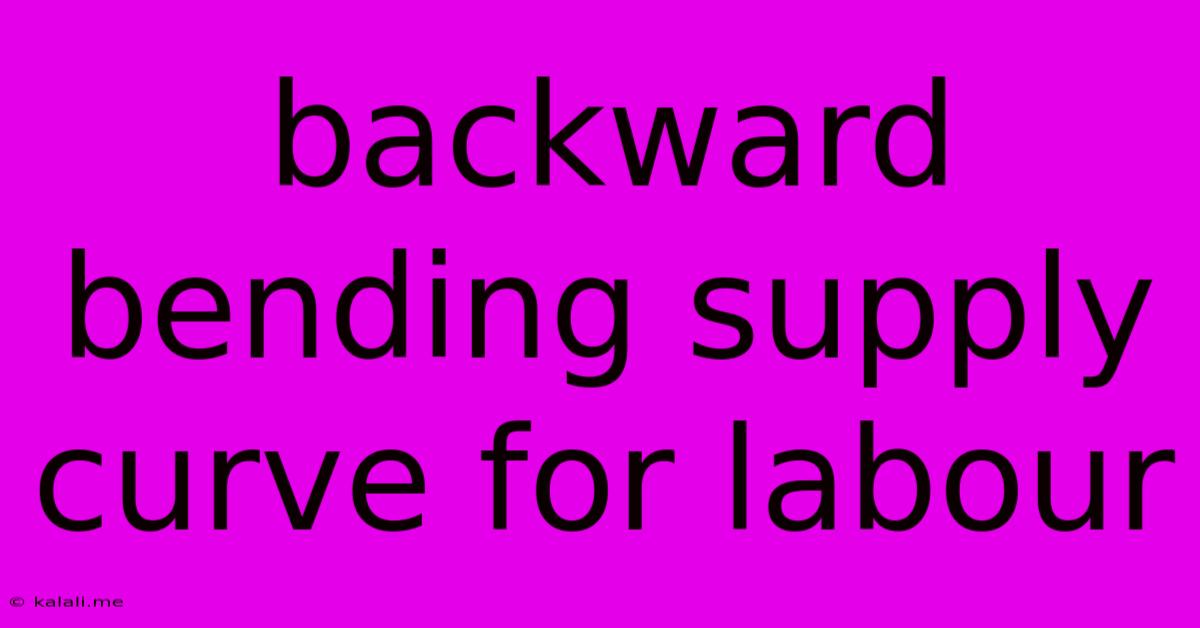Backward Bending Supply Curve For Labour
Kalali
Jun 04, 2025 · 3 min read

Table of Contents
The Backward Bending Supply Curve of Labor: A Deep Dive
Meta Description: Understand the intriguing backward-bending labor supply curve. This article explores the factors behind its unique shape, including income and substitution effects, leisure preferences, and its implications for labor markets.
The standard economic model depicts the supply curve of labor as upward sloping – as wages increase, the quantity of labor supplied also increases. However, under certain circumstances, this relationship can reverse, resulting in a backward-bending supply curve of labor. This phenomenon, while seemingly counterintuitive, is a fascinating example of how individual preferences and economic incentives interact to shape market outcomes. This article will delve into the intricacies of this backward-bending curve, exploring the underlying mechanisms and its real-world implications.
Understanding the Standard Labor Supply Model
Before exploring the backward bend, it's essential to understand the typical upward-sloping supply curve. This curve reflects the substitution effect, where higher wages make work more attractive relative to leisure. As wages rise, individuals are incentivized to substitute leisure time with work to increase their earnings.
The Emergence of the Backward Bend: The Income Effect
The backward bend arises due to the interplay between the substitution effect and the income effect. The income effect considers the impact of higher wages on an individual's purchasing power. As wages increase, workers experience a rise in their real income, even if they work the same number of hours. This increased income allows them to afford more leisure, leading to a potential decrease in the quantity of labor supplied.
The Clash of Effects: Substitution vs. Income
The shape of the labor supply curve depends on the relative strength of the substitution and income effects. At lower wage levels, the substitution effect typically dominates. Individuals are more likely to increase their work hours in response to higher wages to improve their standard of living. However, as wages continue to rise and income levels increase significantly, the income effect begins to outweigh the substitution effect. At this point, individuals may choose to work fewer hours and enjoy more leisure, even though they could earn more by working longer.
Factors Influencing the Backward Bend
Several factors influence the likelihood of observing a backward-bending labor supply curve:
- Individual Preferences for Leisure: People with a strong preference for leisure are more likely to exhibit a backward-bending supply curve. The value they place on free time may outweigh the incentive of higher wages.
- Wage Levels: The backward bend is more likely to be observed at higher wage levels, where the income effect is more substantial.
- Wealth: Individuals with significant wealth may be less inclined to work longer hours even at high wages, as their income needs are already met.
- Non-labor Income: Individuals receiving substantial non-labor income (e.g., inheritance, investments) may be more likely to reduce their working hours as wages increase, prioritizing leisure over additional earnings.
- Taxation: High tax rates can reduce the net income gain from working additional hours, weakening the substitution effect and making the backward bend more likely.
Empirical Evidence and Real-World Implications
While a perfectly backward-bending supply curve is rarely observed in its pure form across the entire labor market, evidence suggests that this effect can be significant for certain groups, particularly high-income earners or those with strong preferences for leisure. Understanding this phenomenon is crucial for policymakers in areas such as tax policy, labor market regulation, and welfare programs.
Conclusion
The backward-bending supply curve of labor is a complex but crucial concept in labor economics. It highlights the importance of considering both substitution and income effects when analyzing labor market dynamics. While the perfect backward bend may be rare, understanding its underlying principles helps explain the observed behavior of workers at different income levels and clarifies the impact of various economic policies on labor supply. Further research continues to explore the nuances and real-world applications of this intriguing economic phenomenon.
Latest Posts
Latest Posts
-
How To Say Hot Chocolate In Spanish
Jun 06, 2025
-
Can You Put Water In The Coolant
Jun 06, 2025
-
Do You Need To Use Cement For Steel Fence Post
Jun 06, 2025
-
Hot Water Tank Leaking From Pressure Valve
Jun 06, 2025
-
Cards With The Same Effect Tcg
Jun 06, 2025
Related Post
Thank you for visiting our website which covers about Backward Bending Supply Curve For Labour . We hope the information provided has been useful to you. Feel free to contact us if you have any questions or need further assistance. See you next time and don't miss to bookmark.